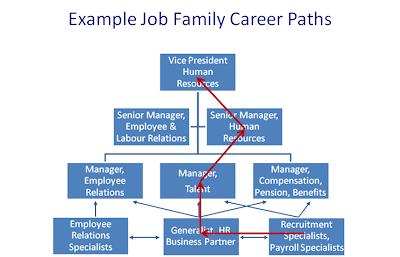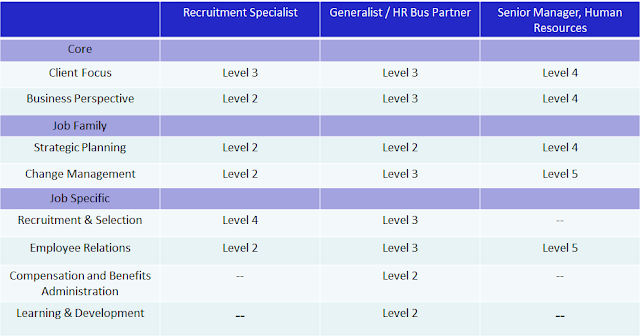This is the eighth in an eleven part series that looks at:
Once you have determined the underlying foundation of your Career Development program, the first two best practice stages to follow include establishing an architecture and competency dictionary, and developing your high level implementation plan.- Making the Case for Competency-based Career Planning & Development
- Facts, Figures & Findings
- Career Planning & Development Defined
- Key Definitions of Career Planning & Development
- Framework for Competency-based Career Planning & Development
- Best Practice Tools & Processes
- Implementing Career Planning & Development – Part 1
- Implementing Career Planning & Development – Part 2
- Implementing Career Planning & Development – Part 3
- Key Considerations for Software, Part 1
- Key Considerations for Software, Part 2
Establish an Architecture and Competency Dictionary to support Career Development.
As noted in the fourth and fifth blogs in this series, fundamental to effective Competency-based Career Planning & Development is a competency architecture that allows employees and managers to compare and contrast competency requirements across roles and levels within or across job groups.
Having Competencies available that are scaled according to proficiency levels, make the job of defining logical career paths and ladders within the organization that much easier. Both employees and the organization can see how jobs relate one to the other both in terms of the competencies and proficiency levels needed for successful job performance.
So often, we have seen organizations adopt one-level competency dictionaries that do not allow for logical links to be drawn between jobs. Having these types of competencies will work well when developing employees within their current jobs, but what about situations in which the organization is attempting to guide employees along career paths that make sense from a competency development perspective. Having scaled competencies starting at a basic level of proficiency and to the highest level of proficiency typically needed within organizations allows the organization and employees to draw relationships in terms of the level of proficiency needed across jobs within the organization. As an example, perhaps a server in a restaurant might be expected to perform at Level 1 of Customer Focus -“Responding to immediate client needs”, whereas an executive in the restaurant chain may be responsible for “Ensuring continued service excellence” (Level 5 proficiency). In this way, jobs can be mapped to the competency proficiency level needed and progression in proficiency can be established across different jobs and levels in the organization. This type of competency scale helps in defining logical career paths and ladders across jobs, and thus supports Career Planning and Development.
Similarly, defining Job Groups / Job Families – i.e., groups of jobs that tend to have common functions / duties and form a logical group for acquiring resources and managing careers (e.g., Finance; Sales; Information Technology; etc.) - also serves to support well-defined Career Development programs within organizations. While career progression can occur in a variety of ways, generally speaking career development is typically planned and occurs within job families. Thus, it is more likely that people with an interest and training in a particular functional area will seek career opportunities within the job family as compared with other job families.
Finally, developing Competency Profiles for typical roles within Job Families provide the foundation for determining potential career paths or streams. This allows both supervisors and employees to see how progression typically occurs. It also allows the organization to develop programs, tools and processes that support progression.
Develop a high-level plan for implementation
Most medium to large organizations cannot implement Competency-based Career Development for all employees at all levels at the same time. This is in part due to the fact that organizations typically tackle the development of competency models / profiles in order of priority within higher need areas (e.g., Leadership levels; targeted at risk Job Groups; etc.). You also have to determine the fundamental building blocks that need to be in place right away – for example, a competency-based assessment process for determining key strengths and gaps, Individual Develop Planning processes; etc.
Having established the priority groups and the fundamental building block tools and processes, it then becomes possible to design and implement career development processes based on priority needs and the key competency areas that need to be addressed within each group.
Part of this decision-making process may include considerations related to creating some “quick wins”. In this case, organizations will often look for high need areas in which to start as well as a key champion who recognizes this need. This serves two purposes:
- It addresses the immediate organizational need; and,
- It demonstrates that value of a competency-based approach to career development.
Hopefully, the leader for the group or area involved will broadly communicate the success of the initiative and convince others of the impact and value to the organization, which in turn will pave the way for others to accept this new way of managing careers.
The next blog in this series covers Part 3 of Implementing Competency-based Career Development. Sign up to our blog’s mailing list through the form on the right-hand side to receive the rest of the series in your inbox.
HRSG is a leader in Competency-based Career Planning and Development solutions. Contact us today to find out how we can help you.
Want to learn more? Competency-based Talent Management, or CbTM, is the best practice for defining job requirements and building effective HR programs to develop skilled, engaged and productive workforces. Download this Best Practice Guide to learn how competencies can increase workforce effectiveness and improve business practices.











